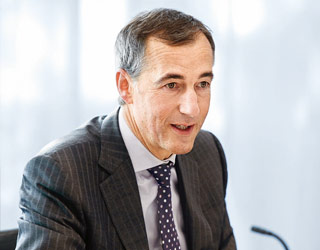Group investments

“Our strong investment result and steady performance provide a significant value driver for the Group.”
Guido Fürer
Group Chief Investment Officer
Strategy
Swiss Re’s investment portfolio maintained its track record of sustainable performance results, with another strong contribution in 2017. All asset classes contributed to the result, reflecting the diversification of investment income sources as well as the quality of the investment portfolio. During 2017, Swiss Re increased its overall allocation to government bonds and credit investments alongside a reduction in cash and short-term investments, enhancing income with low-duration risk. The allocation to equities and alternative investments remained relatively stable. While the investment portfolio is well-positioned overall, the Group maintains suitable flexibility should it be presented with attractive market opportunities or a change in the investment outlook.
Financial markets overview
Financial markets continued to centre on monetary policy and broader political developments in 2017. On the political front, while the French presidential election in April and May ultimately turned out as expected, uncertainty in the US and the UK remained high due to economic policy and Brexit, respectively.
That being said, financial markets largely shrugged off the political uncertainty. Equity markets rallied through most of the year, with the S&P 500 reaching new all-time highs and returning more than 20% in 2017. Investment-grade corporate bond spreads tightened further, reaching multi-year lows, while government bond yields ended 2017 at levels broadly similar to those at the beginning of the year. Notably, financial market volatility has remained exceptionally low across the major asset classes.
The positive investor sentiment and benign market environment was supported by stronger-than-expected economic growth data, with the global recovery becoming more solid and broad-based across regions. At the same time, inflationary pressures remained subdued, which allowed central banks to slowly and carefully start to normalise monetary policy.
Investment result
Net investment income
in USD billion, 2017
3.7
(2016: USD 3.7 billion)
Group return on investments
2017
3.9%
(2016: 3.4%)
Fixed Income Running Yield
2017
2.9%
(2016: 2.9%)
The Group’s investment portfolio, excluding unit-linked and with-profit investments, increased to USD 131.7 billion at the end of 2017, compared to USD 130.5 billion at the end of 2016. The increase was driven by positive returns from most asset classes and a weakening of the US dollar.
The return on investments for 2017 was very strong at 3.9%, with over 85% of the result attributable to net investment income as well as net realised gains from equities and alternative investments. This compared to a return on investments of 3.4% in 2016, with the increase primarily due to additional net realised gains related to equity securities. The Group’s non-participating net investment income was relatively stable at USD 3.7 billion in 2017 compared to the prior year. The Group’s fixed income running yield was steady at 2.9%.
The Group reported non-participating net realised investment gains of USD 1.7 billion in 2017 compared to USD 1.5 billion in 2016, as additional realised gains from sales within the equity portfolio were partially offset by the absence of gains from derivatives.
Outlook
The focus in 2018 is set to remain on central bank policy, inflation and global political developments. In terms of economic outlook, global economic growth is expected to stay solid, both in developed and emerging market economies, while inflation is forecast to modestly increase globally. This, in turn, should allow the key central banks to continue their cautious policy normalisation path. The Federal Reserve is set to hike rates further (while slowly reducing the size of its balance sheet), and the European Central Bank is likely to fully wind down its asset purchase programmes by the end of the year. From a regional perspective, growth should stay solid in both the US and the Eurozone, but be more modest in the UK amid continued Brexit-related uncertainty. Meanwhile, economic growth in China next year is expected to moderately slow from current levels.
Risks to the outlook are seen as broadly balanced, with inflation and political developments (eg Brexit negotiations, Italian elections, the formation of a grand coalition in Germany) being the key factors to watch. Still, given the current stage of the economic cycle set against the backdrop of generally high asset valuations, we will maintain a well-diversified and high-quality investment portfolio.